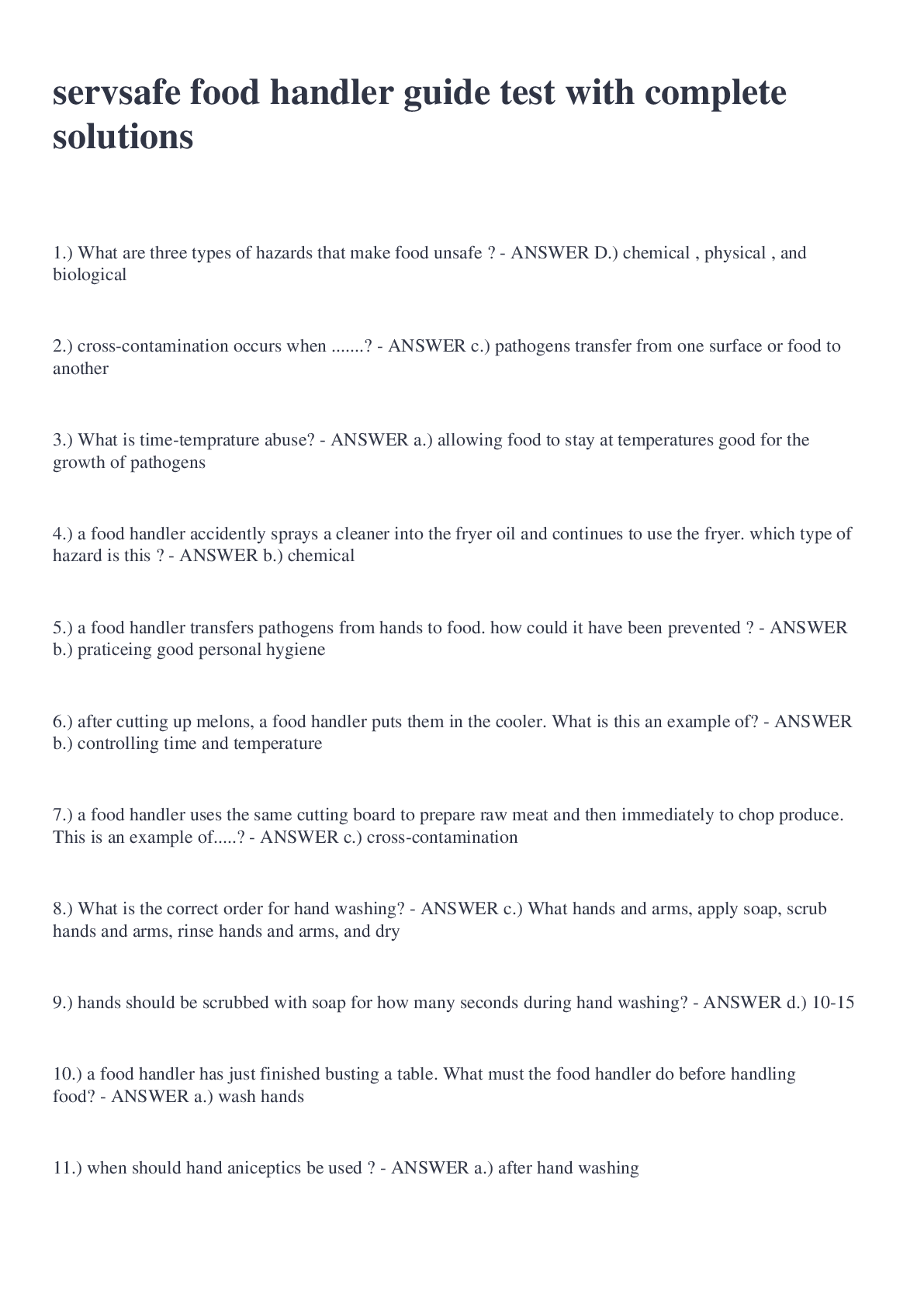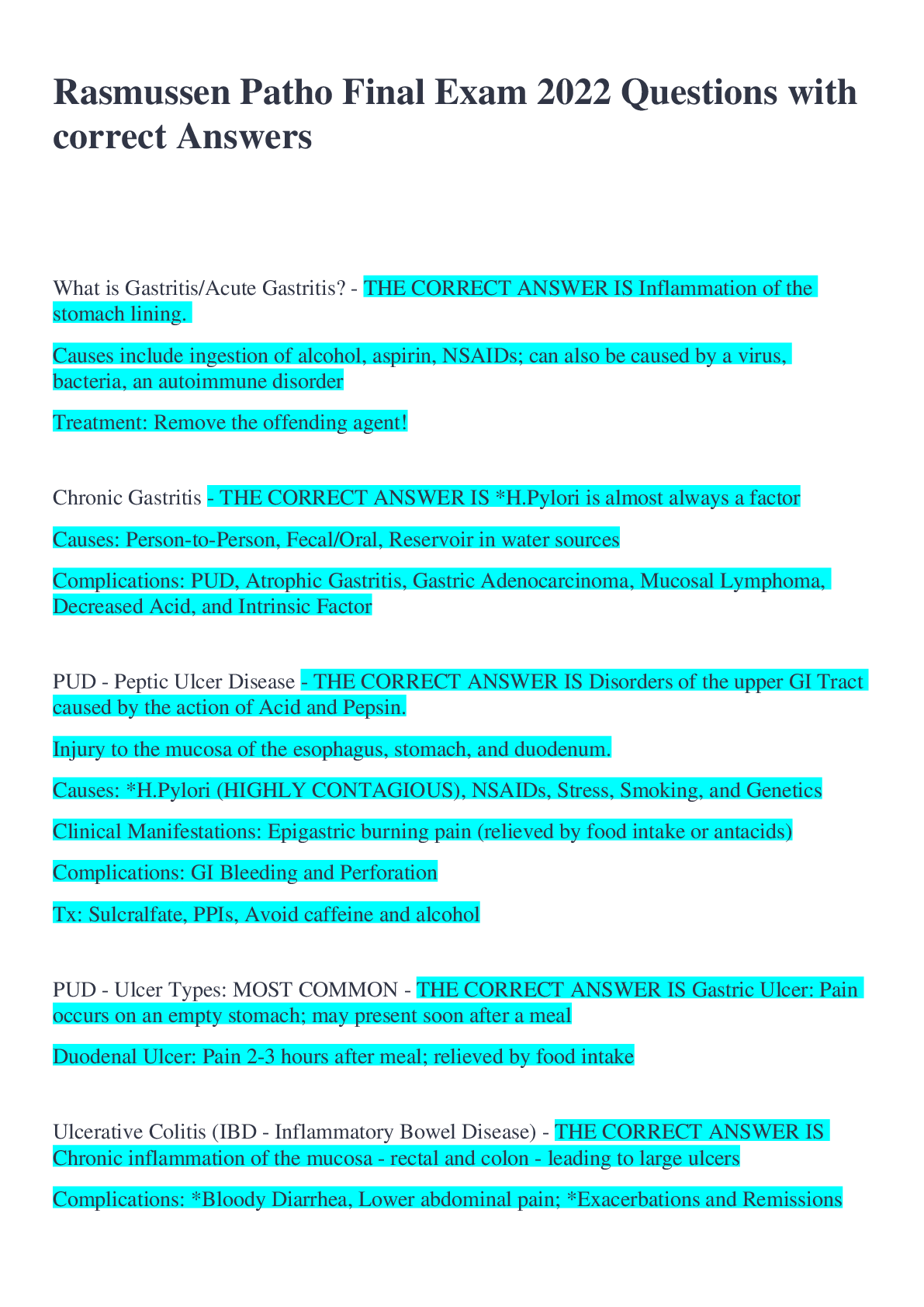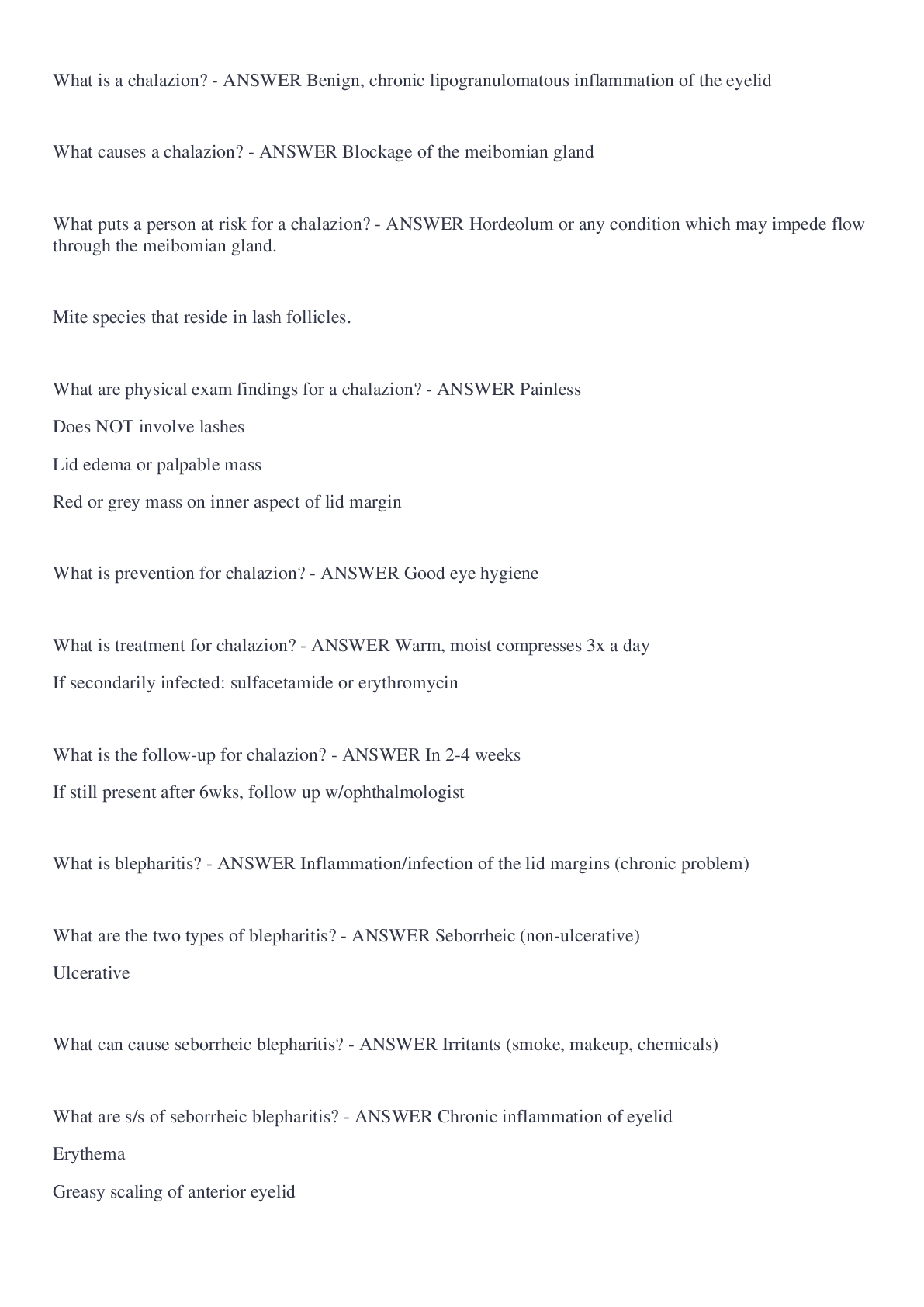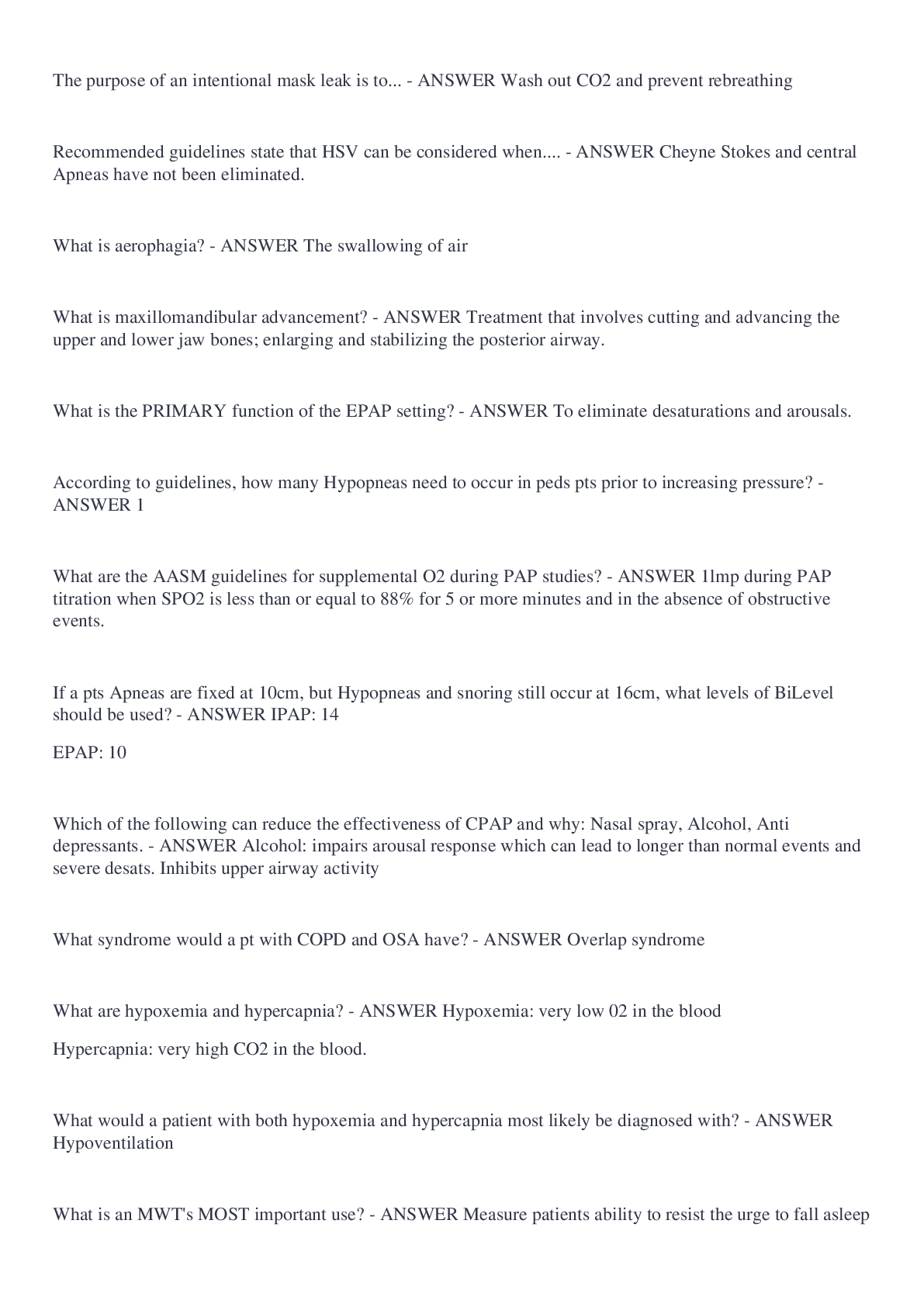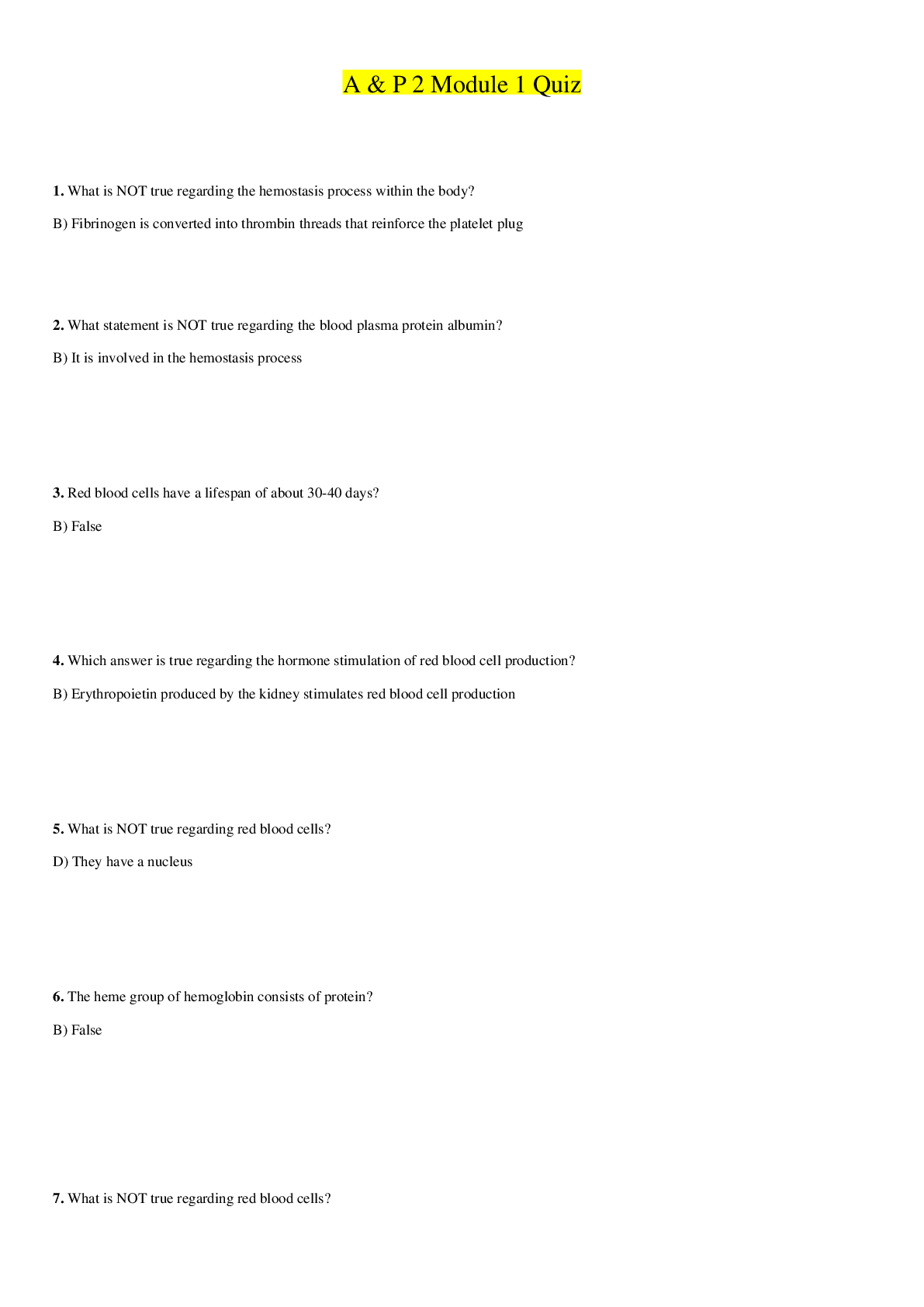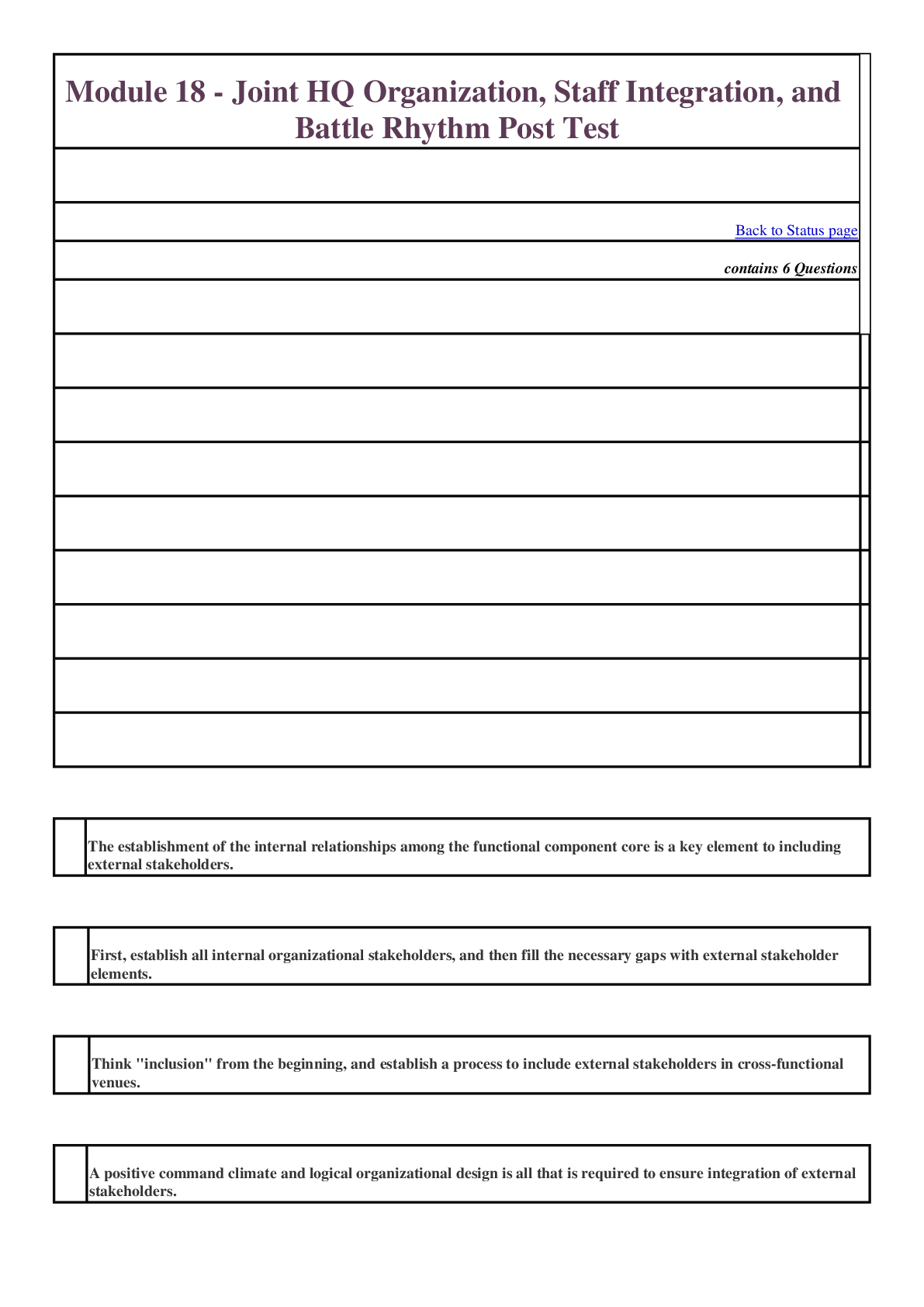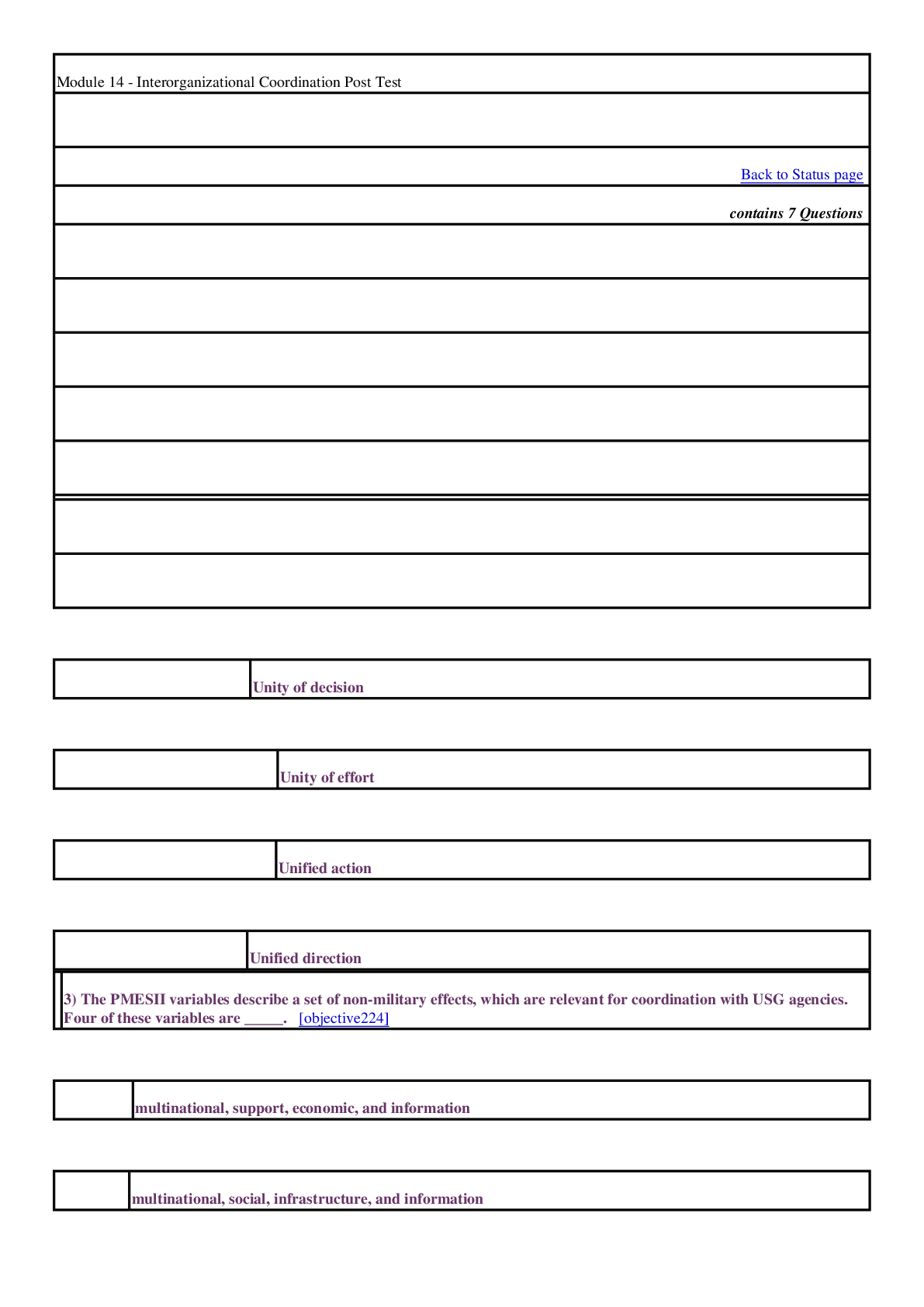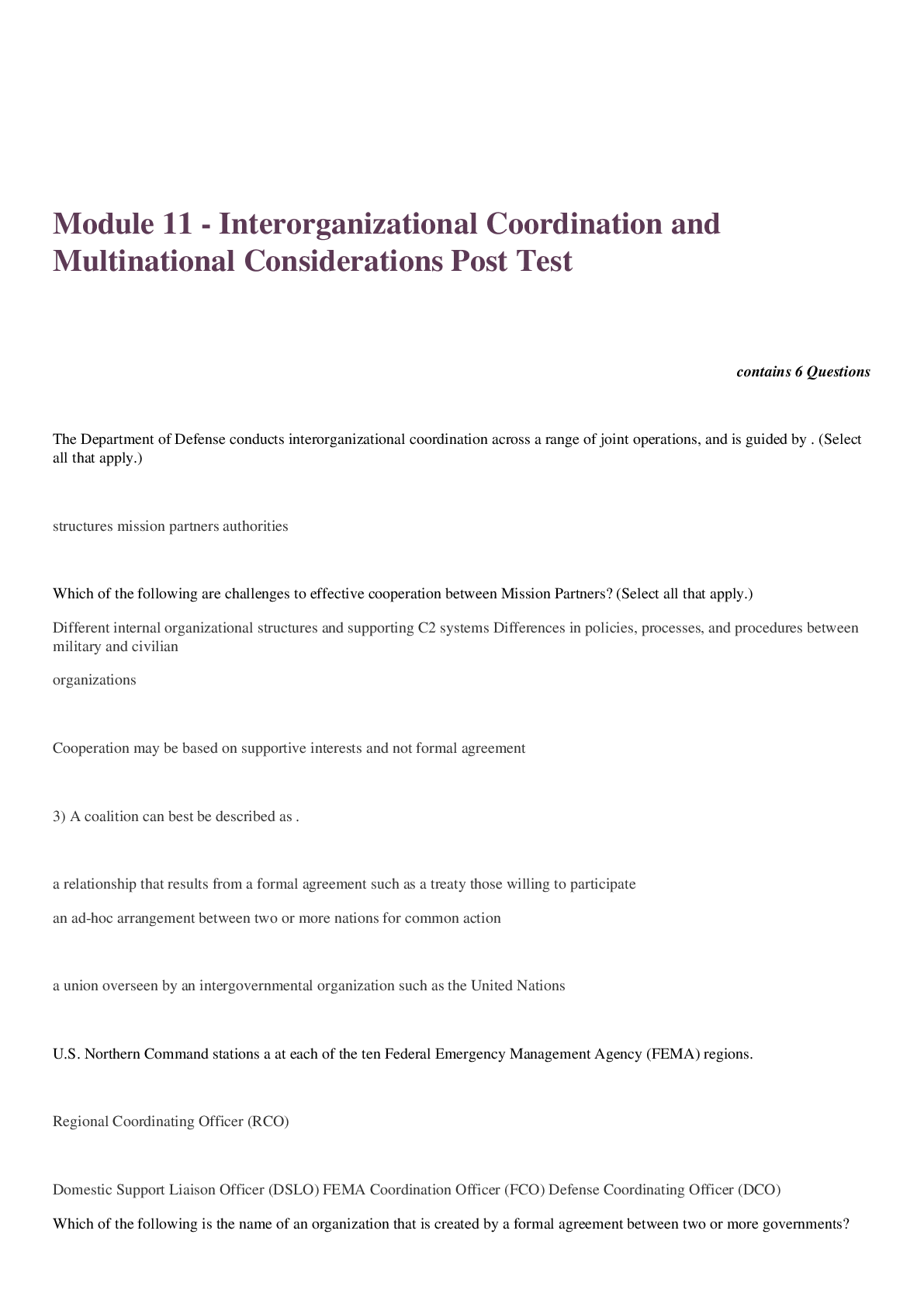Computer Science > EXAM > Mule Developer I Module 1 – 7 with complete solutions (All)
Mule Developer I Module 1 – 7 with complete solutions
Document Content and Description Below
What is Anypoint Exchange - ANSWER -A library of assets -The central repo for building app network -Ensures assets are published for reuse What does Exchange contain - ANSWER -Public assets provi... ded by Mule -Private content for the org, including thorough documentation API Portal - ANSWER -Auto-generated when a REST API is added to Exchange -Has: *Auto-generated API docs *API Console for consuming and testing *Auto-generated endpoint and mocking service -Can be shared with internal and external users REST Connectors in Exchange - ANSWER -When RAML spec is added, a connector is created *REST Connect: Connector can be used in Mule app to make calls to the API Design Center: API Designer - ANSWER Web app for designing, documenting and mocking APIs. Design Center: Flow Designer - ANSWER -Web app for building integration apps that connect systems and consume api -Simplified capabilities from Anypoint Studio -When an app is created, it is deployed to an run by CloudHub worker, a Mule hosted runtime Design Center: Anypoint Studio - ANSWER Desktop IDE for implementing APIs and building integration apps Mule Runtime - ANSWER -Java-based ESB that allows developers to connect apps together to exchange data -Decouples point-to-point as all other apps interface with the bus (Mule runtime) -Can be deployed anywhere: realtime or batch -Enforces policies for API governance? Mule Application - ANSWER -Receives events, processes them, and routes them to other endpoints -Accepts and processes a Mule event through a series of processors plugged together in a flow -Consists of one or more flows (that can be connected together) Mule 4 flow composition - ANSWER -Mule event source (can be triggered) -Mule event processors *Transform, filter, enrich, etc... CloudHub worker - ANSWER -MuleSoft-hosted Mule runtime that runs Mule apps created in flow designer -Each worker runs in a separate container and is deployed / monitored independently -Workers can be scaled for different memory and processing capabilities -Workers in different environments (Design, Sandbox, Prod) and can be promoted RAML - ANSWER Restful API Modeling Language Mocking Service - ANSWER Allows live simulation of API. Run from the API console. Mule event structure - ANSWER Mule message: Data the passes through flows in the app Attributes: -Metadata of the mule message. -Contained in the message header Payload: data that is to be processed Variables: Metadata for the Mule event MUnit - ANSWER Mule app testing framework Global configuration element - ANSWER Reusable configuration for many operations Defines a connection to a resource DataWeave 2.0 - ANSWER Expression language in Mule to access, query, and transform Mule event data Transform Message Component - ANSWER -GUI wiht payload aware development -Dataweave can be used for transform APIkit - ANSWER -Open-source toolkit that includes an Anypiont Studio plugin -Generate an interface automatically from RAML -Generates a routing flow and flows for each of resource/method pairs -Add processors to hook up backend logic https://docs.mulesoft.com/apikit/3.x/apikit-basic-anatomy Anypoint Studio Anatomy - ANSWER Package Explorer Canvas Palette Console Anatomy of a flow - ANSWER Event Source Event Processors Error handling - ANSWER Deployment options - ANSWER -Embedded runtime in Anypoint Studio -CloudHub -Customer-hosted Mule runtimes Embedded Runtime - ANSWER Deployment option during development CloudHub - ANSWER -PaaS component of Anypoint Platform -MuleSoft-hosted Mule runtimes on AWS -Fully managed, multi-tenant, gobal, secure, etc... Customer-hosted Mule Runtimes - ANSWER -Bare metal or cloud service provider: AWS, Azure, and Pivotal Cloud Foundry -Can run multiple apps -Uses Java Service Wrapper that controls JVM from OS and starts Mule -Can be managed by Runtime Manager in private or hosted Anypoint Platform CloudHub Benefits - ANSWER -No hardware -Continuous updates -Provided infrastructure for DNS and load-balancing -Built-in elastic scalability for high demand -99.99% uptime SLA -PCI, HiTrust, and SSAE-16 certified Deploying applications to CloudHub - ANSWER From: -Anypoint Studio* -Anypoint Platform* *Must set worker size and number -Flow Designer -Cloudhub requires Enterprise or Partner license! CloudHub Workers - ANSWER -Dedicated instance of mule that runs an app -Can be scaled in processing or memory Scaling Workers - ANSWER -Vertically by changing the worker size -Horizontaly by adding multiple workers Worker Characteristics - ANSWER -Capacity: Each worker has a specific amount of capacity to process data, you can select the size of your workers when configuring an application. -Isolation: Each worker runs in a separate container from every other application. -Manageability: Each worker is deployed and monitored independently. -Locality: Each worker runs in a specific worker cloud, the US, EU, Asia-Pacific, etc. (12 regions) Worker Sizes - ANSWER -0.1 vCores + 500 MB Heap Memory -0.2 vCores + 1 GB Heap Memory -1 vCores + 1.5 GB Heap Memory -2 vCores + 3.5 GB Heap Memory -4 vCores + 7.5 GB Heap Memory -8 vCores + 15 GB Heap Memory -16 vCores + 32 GB Heap Memory Worker Multitenancy - ANSWER First, the worker cloud is a multitenant cloud of virtual machines. These VMs provide the security and isolation needed for your integrations to run custom code without affecting others. Second, the management console and the platform services have a "shared everything" architecture - all tenants share the same web UI, monitoring services, load balancers, etc. These services do not process or transmit your data. CloudHub Benefits - ANSWER Provides: -Scalability -Workload distribution (load-balancing) -Persistent Queueiing Worker Scaling Limits - ANSWER -128 vCores -8 workers -Availability determined by subscription/license -Batch jobs only run on 1 worker Persistent Queue - ANSWER -Guarantees delivery of message -Allows parallel processing between workers on the same data -View in Queues tab of runtime manager -4 days retention -Optional data-at-rest encryption -Does not guarantee one-time-only delivery CloudHub features - ANSWER -Worker scale out -Persistent queue -Enabled: -When deploying app to CloudHub -From deployment tab in Runtime Manager Reliable Acquisition Flow - ANSWER -Flow feeding Queue VM -Delivers a message to an outbound VM endpoint. -If the flow cannot put the message into the VM queue, it returns an "unsuccessful request" response to the client to retry Application Logic Flow - ANSWER -Flow receiving from Queue VM -Delivers the message from an inbound VM endpoint to the business logic. -May include multiple transactions Persistent VM Queue - ANSWER -Holds messages committed by reliable acquisition flow -Processing error or timeout results in rollback which places message back on queue API Proxy - ANSWER -An application that controls access to a web service -Restricts access and usage through an API Gateway API Gateway - ANSWER -Runtime designed and optimized to host an API or to open a connection to an API deployed to another runtime -Determines which traffic is authorized -Meters the traffic -Logs / collects data / tracks for analytics -Enforce governance: rate limiting, throttling, caching Using API Manager to manage access to APIs - ANSWER -Create proxy applications -Deploy proxies to an API Gateway runtime -Specify throttling, security, and other policies -Specify tiers with different access -Control access -Promote managed APIs between environments -Review analytics API Manager vs API Gateay - ANSWER -API Manager manages access to the proxies: define SLA and apply runtime policies (*note: API Manager is a licensed product - optional) -API Gateway enforces the policies Policies to restrict access - ANSWER -Out of box: Rate limiting, spoke control, security -Custom policies with XML and YAML -Apply multiple policies SLA Tiers - ANSWER -Restrict access by client restrict by client Id -Defines the # of requests that can be made per time frame -Request approval can be set to automatic (free) or manual (for tiers that cost $) SLA Based Policy - ANSWER -Allows access to AIP using SLA tiers -Requires applications to 1 Register for access to a specific tier from api portal in exchange 2 Pass their client credentials in the calls Requesting access to SLA tiers - ANSWER -If an API has an SLA-based policy, a request API access button in API portal will appear -Belong to Anypoint Platform org and logged in (they need to have Exchange access) -Register/add an app to their Anypoint Platform account -Select a tier Approving SLA tier access - ANSWER -Manual approval: Emails are sent to the org admin -Org admin can review the app in API manager and approve, reject, or revoke -Client Id is generated -Client Id and secret requirements need to be added to header Event data populated by HTTP request - ANSWER -Header content becomes json attributes -Data becomes payload Viewing event data at design time - ANSWER -Transform Message component -DataSense Explorer -Writing expressions using auto-completion (Is this the metadata in the flow?) DataSense - ANSWER Ability to proactively discover metadata: -i.e. Table schema from SQL Viewing event data at run time - ANSWER -In the client making a request (since that's where the event data originates...) -Log files -Console -Using Visual Debugger Logger component - ANSWER -View mule event data -Visible in Console and log files Debugging a mule application - ANSWER -Breakpoints on processors to step. Watch: -Event properties and values -Dataweave expressions (and evaluate) -Default listens for incoming TCP from port 6666 Inline expressions - ANSWER #[ ] enclosed -Used to dynamically set value of properties in an event processor or global config element Referencing mule objects in Dataweave - ANSWER Server = #[server.osName] mule = #[mule.version] app = #[app.name] flow = #[flow.name] message = #[message.payload] attributes = #[attributes.queryParams.param1] payload = #[payload] vars = #[vars.foo] Accessing event attributes - ANSWER #[ _some message component_] is used. I.e.: #[attributes.method] will show http method #[Payload.someParameterName] will return value of someParameterName parameter Selectors in Dataweave expressions - ANSWER -single value select = #[payload.parameter] -array = #[payload[0].name] -array, multi-selector = #[payload.*name] -array, descendants selector = #[payload..zip] Operators in dataweave - ANSWER Arithmetic - +,=,/,* Equality - ==, !=, ~= Relational - >, >=, <, <=, is Conditional - and,or, not Type coercion - 'as' Default value - 'default' if / else if / else in dataweave - ANSWER if (payload.age < 15) group: "child" else if (payload.age < 25) group: "youth" else group: "senior" Dataweave - ANSWER -Packaged in mule -Core functions are imported automatically -Functions with 2 parameters have alternate syntax - #[contains(payload,max)] - #[payload contains "max"] -Reference: https://docs.mulesoft.com/mule-runtime/4.1/dataweave Variables - ANSWER -#[vars.foo] -Uses Set Varaible component -Persistent through flow references -Not through transport barrier (i.e. VM queues) Flows vs. Subflows - ANSWER -Flows: Can have their own error handling, subflows cannot Private flows - ANSWER -Flows without event sources Creating new flows/subflows - ANSWER -Add a new scope: Flow or subflow -Drag any event processor on the canvas -Right-click processors and Extract to Flow Reference - ANSWER -Synchronous reference to another flow VM Connector - ANSWER -Asynchronous flow to flow comm -Achieve parallelism in processing -Allow more specific tuning with the flow architecture -Distribute work across a cluster -Communicate with another app in the same domain -Implement simple queuing VM Connector: Queues - ANSWER -Transient: faster, but volatile -Persistent: slower but non-vola VM Connector: Publish vs. Publish Consume - ANSWER Connector queue is asynchronous, so: -Publish Consume: consumes the processed event from the consumer. -Publish: publishes and continues - does not receive the processed event from consumer. Domain project - ANSWER -Used to share global configs between apps -Expose multiple services within domain on same port -Share connections to persistent storage -Call flows in other apps with VM connector -***Not available on CloudHub*** Organizing Global Configs - ANSWER -All global configs can be placed into a new Mule config file and referenced by other flows in the same project/app. Application Properties - ANSWER -Easier way to manage connector properties, credentials, configs -Replace static values -Defined in .yaml or .properties -Implemented with property placeholders -Can be encrypted [Show More]
Last updated: 1 year ago
Preview 1 out of 13 pages
Instant download
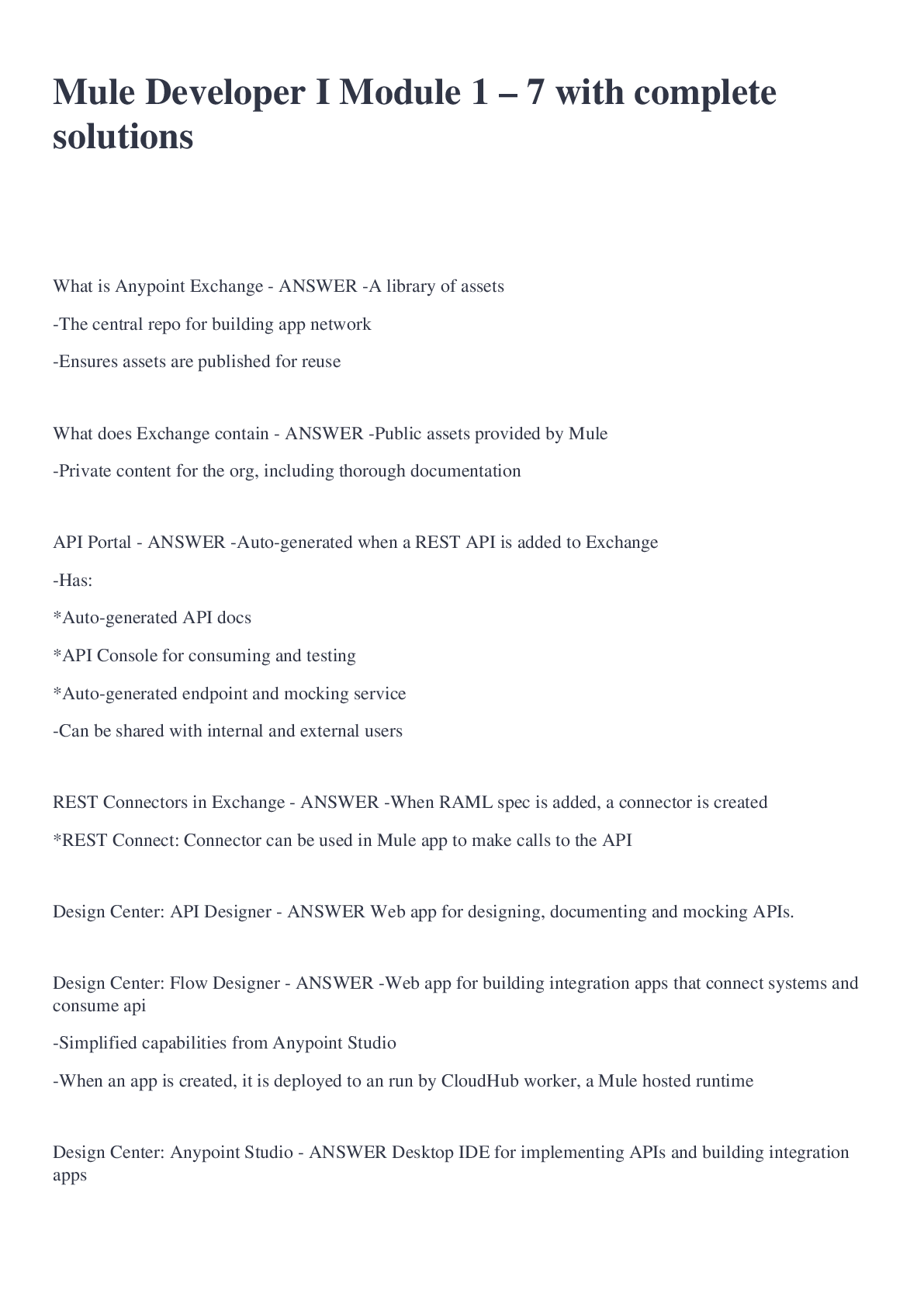
Buy this document to get the full access instantly
Instant Download Access after purchase
Add to cartInstant download
Reviews( 0 )
Document information
Connected school, study & course
About the document
Uploaded On
Sep 09, 2022
Number of pages
13
Written in
Additional information
This document has been written for:
Uploaded
Sep 09, 2022
Downloads
0
Views
50



